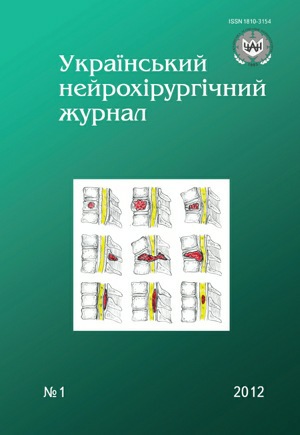Diagnosis and treatment of cavernous malformations of the spine and spinal cord
DOI:
https://doi.org/10.25305/unj.57746Keywords:
cavernous malformation, surgical treatmentAbstract
Introduction. This study was conducted in order to clarify structural features of cavernous malformations, to develop a technique for their surgical treatment and to analyze treatment outcomes.
Methods. In 36 patients with cavernous malformations of spine and spinal cord open surgical interventions have been performed, 52 patients received conservative treatment. Clinical signs, radiology data, results of surgical treatment, radiation treatment and medicines application were analyzed, as well as operative findings and histological studies data of removed malformation tissue.
Conclusion. The treatment tactic is determined by the existence and severity of spinal compression syndrome. If the syndrome is non-existent or has initial signs, radiation treatment is justified. Surgical intervention is indicated if it is necessary to eliminate radiculo-medullary compression.
In case of intradural extra- and intramedullar cavernous malformations open surgical intervention to remove the malformation is required.
References
1. Park S, Jahng T, Chung C. The clinical outcomes after complete surgical resection of intramedullary cavernous angiomas: changes in motor and sensory symptoms. Spinal Cord. 2009;47(2):128-133. [CrossRef]
2. Toldo I, Drigo P, Mammi I, Marini V, Carollo C. Vertebral and spinal cavernous angiomas associated with familial cerebral cavernous malformation. Surg Neurol. 2009 Feb;71(2):167-71. [CrossRef] [PubMed]
3. Noudel R, Litré F, Vinchon M, Patey M, Rousseaux P. Intramedullary spinal cord cavernous angioma in children: case report and literature review. Childs Nerv Syst. 2008 Feb;24(2):259-63. [CrossRef] [PubMed]
4. Murillo-Bonilla LM, Cantú-Brito C, Arauz-Góngora A, Higuera-Calleja J, Padilla-Rubio J, Barinagarrementeria-Aldatz F. [Cavernous angioma. Clinical observations and prognosis of 133 patients]. Rev Invest Clin. 2003 Jul-Aug;55(4):387-93. [PubMed]
5. Cecchi PC, Rizzo P, Faccioli F, Bontempini L, Schwarz A, Bricolo A. Intraneural cavernous malformation of the cauda equina. J Clin Neurosci. 2007 Oct;14(10):984-6. [CrossRef] [PubMed]
6. Nishikawa M, Ohata K, Ishibashi K, Takami T, Goto T, Hara M. The anterolateral partial vertebrectomy approach for ventrally located cervical intramedullary cavernous angiomas. Neurosurgery. 2006 Jul;59(1 Suppl 1):ONS58-63. [CrossRef] [PubMed]
7. Obermann M, Gizewski ER, Felsberg J, Maschke M. Cavernous malformation with hemorrhage of the conus medullaris and progressive sensory loss. Clin Neuropathol. 2006 Mar-Apr;25(2):95-7. [PubMed]
8. Bakir A, Savas A, Yilmaz E, Savaş B, Erden E, Cağlar S, Sener O. Spinal intradural-intramedullary cavernous malformation. Case report and literature review. Pediatr Neurosurg. 2006;42(1):35-7. [CrossRef] [PubMed]
9. Santoro A, Piccirilli M, Bristot R, di Norcia V, Salvati M, Delfini R. Extradural spinal cavernous angiomas: report of seven cases. Neurosurg Rev. 2005 Oct;28(4):313-9. [CrossRef] [PubMed]
10. Caruso G, Galarza M, Borghesi I, Pozzati E, Vitale M. Acute presentation of spinal epidural cavernous angiomas: case report. Neurosurgery. 2007 Mar;60(3):E575-6. [CrossRef] [PubMed]
11. Wada M, Takahashi H, Matsubara S, Hirai S. Occult vascular malformations of the spinal cord: report of four cases not detected by angiography. Acta Neurol Scand. 2000 Feb;101(2):140-3. [CrossRef] [PubMed]
12. Wakabayashi Y, Isono M, Shimomura T, Tajima A, Terashi H, Asada Y, Izumi T, Hori S. Neurocutaneous vascular hamartomas mimicking Cobb syndrome. Case report. J Neurosurg. 2000 Jul;93(1 Suppl):133-6. [CrossRef] [PubMed]
13. Jones JO, Bruel BM, Vattam SR. Management of painful vertebral hemangiomas with kyphoplasty: a report of two cases and a literature review. Pain Physician. 2009 Jul-Aug;12(4):E297-303. [CrossRef] [PubMed]
14. Guarnieri G, Ambrosanio G, Vassallo P, Pezzullo MG, Galasso R, Lavanga A, Izzo R, Muto M. Vertebroplasty as treatment of aggressive and symptomatic vertebral hemangiomas: up to 4 years of follow-up. Neuroradiology. 2009 Jul;51(7):471-6. [CrossRef] [PubMed]
15. Peh WC, Munk PL, Rashid F, Gilula LA. Percutaneous vertebral augmentation: vertebroplasty, kyphoplasty and skyphoplasty. Radiol Clin North Am. 2008 May;46(3):611-35, vii. [CrossRef] [PubMed]
16. Burton AW, Hamid B. Kyphoplasty and vertebroplasty. Curr Pain Headache Rep. 2008 Jan;12(1):22-7. [CrossRef] [PubMed]
17. Rawat S, Nangia S, Ezhilalan RB, Bansal AK, Ghosh D. Variance in the treatment of vertebral haemangiomas. J Indian Med Assoc. 2007 Jan;105(1):42, 44-48. [PubMed]
Downloads
Published
How to Cite
Issue
Section
License
Copyright (c) 2012 Eugene Slynko, Alexander Zolotoverkh, Vadim Verbov, Ruslan Pishanov

This work is licensed under a Creative Commons Attribution 4.0 International License.
Ukrainian Neurosurgical Journal abides by the CREATIVE COMMONS copyright rights and permissions for open access journals.
Authors, who are published in this Journal, agree to the following conditions:
1. The authors reserve the right to authorship of the work and pass the first publication right of this work to the Journal under the terms of Creative Commons Attribution License, which allows others to freely distribute the published research with the obligatory reference to the authors of the original work and the first publication of the work in this Journal.
2. The authors have the right to conclude separate supplement agreements that relate to non-exclusive work distribution in the form of which it has been published by the Journal (for example, to upload the work to the online storage of the Journal or publish it as part of a monograph), provided that the reference to the first publication of the work in this Journal is included.









